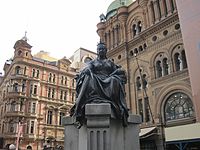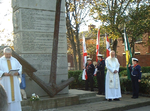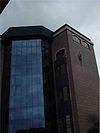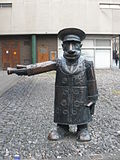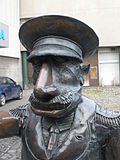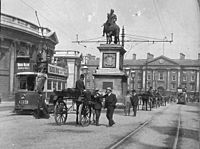- Statues in Dublin
-
Dublin statues are a significant feature of the cityscape of Dublin and many have acquired nicknames. The city's statues and other monuments have a long history of controversy about their subjects and designs, and a number of formerly prominent monuments have been removed or destroyed.
Daniel O'Connell - 19th century nationalist leader
 Nelson's Pillar - Blown up by Irish republicans in 1966
Nelson's Pillar - Blown up by Irish republicans in 1966
 Henry Grattan - 19th century statue in College Green
Henry Grattan - 19th century statue in College Green

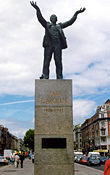 James Larkin - The great appear great because you are on your knees - Arise
James Larkin - The great appear great because you are on your knees - Arise
 Dublin's newest statue, Phil Lynott on Harry Street
Dublin's newest statue, Phil Lynott on Harry Street
Contents
O'Connell Street
Dublin's most prominent monument, Nelson's Pillar, which stood near the General Post Office (GPO) in the centre of O'Connell Street, was blown up by Saor Eire in 1966, as their way of commemorating the fiftieth anniversary of the Easter Rising. Saor Éire only demolished the top of the pillar, what remained was known as "The Stump", until it was blown up by the Army bomb squad for safety reasons two days after.
Nelson was pre-dated by a 1759 statue of Lord Blakeney, the heroic but unsuccessful defender of the Siege of Fort St. Philip (1756) on Minorca. This was said to be the first statue of an Irishman in Dublin, and was sculpted by John van Nost the Younger.
On the site of the Pillar, a new monument was erected in January 2003. Officially named the Monument of Light but more commonly known as the Spire of Dublin, this tall needle-like structure has already received a number of nicknames including The Spike, The Binge Syringe, The Stiletto in the Ghetto, The Nail in the Pale (see the Pale), The Pin in the Bin, The Stiffy at the Liffey, The Erection in the Intersection and The Rod to God. To erect the new monument, a notorious 1980s monument to the personified river Liffey, Anna Livia, was removed from nearby on O'Connell St. A woman sitting on a slope with bubbling water running down past her represented the river. It rapidly came to be nicknamed the Floozie in the Jacuzzi, the Hoor in the Sewer ("hoor" is a dialectal Irish version of "whore", and in a "working class" Dublin accent, rhymes with sewer).
Other monuments still surviving on O'Connell Street include statues honouring Charles Stewart Parnell by Augustus Saint-Gaudens at the north end of the street; at the southern end stands a statue of Daniel O'Connell by John Henry Foley. Other statues on the street include one of trade union leader James Larkin.
Nearby, outside St. Mary's Pro-Cathedral stands a statue honouring the Dublin Martyrs, Mayor Francis Taylor and his grandmother-in-law Mayoress Margaret Ball.
North Earl Street runs right onto the base of the Spire. At this junction is a statue of James Joyce, the world-famous Irish writer, walking with a cane in his hand. It is known to the Dublin populace as "The Prick with the Stick".[1]
Just by the Ha'penny Bridge is a statue of two women sitting on a bench engaged in conversation with their shopping bags at their feet — they are known famously as "The Hags with the Bags".[2]
A short distance away from O'Connell Street by the banks of the Liffey lies the site of an ill-fated millennium clock, erected in the mid-1990s to count down the hours, minutes and seconds to the year 2000. The clock, with a green-illuminated digital face, was placed underneath the surface of the river by the bank so that the time shone up through the water. A postcard booth was placed on the bridge above the clock that printed postcards for 20p, each bearing the exact amount of time left at that moment until the dawn of the new millennium. However, the clock entered a period of chronic ill health: it had to be temporarily removed to allow a rowing-boat race to pass by and in the months that followed, it had repeated problems with letting in water and failing to display the time correctly. It was removed after a brief period, but not before it had been variously nicknamed "The Time in the Slime", and "The Chime in the Slime" by the people of Dublin. Also it received the nickname "An Rud in the Mud" (a usage of the Gaelic word rud, meaning "thing" or an object of no actual function — the implication being that the clock was of no practical use, even when it worked).[citation needed] A rectangular hole left in the side of the bridge was later filled with a hoax plaque commemorating a fictitious priest, Father Pat Noise.[3][4]
On College Street, outside Trinity College, the traffic island that a statue to the nineteenth-century lyricist Thomas Moore shares with a public toilet has long been known as "The Meeting of the Waters", thus neatly honouring both the civic facility and a famous poem of the writer.[5]
Another statue to earn a dubious but comical nickname is a monument at the bottom of Grafton Street representing Molly Malone, a fictitious fishmonger featured in Dublin's anthem, Molly Malone, who is shown, with ample cleavage, wheeling a cart. The statue was erected to celebrate Dublin's millennium in 1988 (although Dublin was more than 1,000 years old at the time, see History of Dublin), and is generally known in Dublin as "The Tart with the Cart", "The Dolly with the Trolley", "The Trollop with the Scallop", "The Dish with the Fish" or "The Flirt in the Skirt".[6]
On the north-east corner of St Stephen's Green, a semicircle of rough stone pillars commemorating the Irish Famine and surrounding a statue of Wolfe Tone, is sometimes called Tone-henge (after Stonehenge). In Merrion Square, inside the north west corner gateway, there is a statue of Oscar Wilde composed of different coloured stone, sitting on a large granite boulder. This has been nicknamed The Queer with the Leer, The Fag on the Crag or The Quare in the Square ("quare" being a dialectal Irish pronunciation of queer).[7]
James Connolly is the only leader of the 1916 Rising to have a statue in Dublin. It is situated facing Liberty Hall, the headquarters of Ireland's largest trade union, SIPTU. Constance Markievicz has a statue on Tara Street, she had as big a role in the rising as future presidents of Ireland did. For example, statues were never erected to figures like Éamon de Valera,[8] W. T. Cosgrave, Seán Lemass, or any of the presidents of Ireland. One of the few elected politicians commemorated with a statue is Henry Grattan, a leading politician of the 1780s in the old Irish Parliament. A nearby statue of patriot Thomas Davis has earned the nickname "Frankenstein" due to the out of scale hands and odd shaped body given to the nationalist leader in the 1960s work.
Former statues
Dublin was once famed for its high quality equestrian statues, including the Lord Gough monument in the Phoenix Park, the William of Orange statue by Gibbons in College Green and the King George II statue in St Stephen's Green. No statues of people on horseback remain today, as the IRA has since blown them all up. There is, however, a modern equestrian statue outside the "Break for the Border" nightclub on Stephen Street. The statue consists of an American Indian mounted on horseback.[citation needed]
One statue not destroyed was that of Queen Victoria by Irish sculptor John Hughes, which was unveiled outside Leinster House, now the seat of Oireachtas Éireann, by Edward VII in 1904. Noel Lemass TD remarked of the statue in Dáil Éireann "I think we all agree it is one of the most ugly statues of that royal lady..."[9] Nicknamed "The Auld Bitch", it was removed in 1947 and transferred to storage at the Royal Hospital Kilmainham. In the late 1980s, it was given to the city of Sydney, Australia, where it now stands outside the Queen Victoria Building in the city centre.[10] Also that of Lord Gough, sculpted by Dubliner JH Foley, has been moved to Chillingham Castle.
List of Dublin statues (people)
- Daniel O'Connell - O'Connell St.
- Charles Stewart Parnell - O'Connell St.
- Sir John Gray - O'Connell St.
- Jim Larkin - O'Connell St.
- Theobald Mathew (temperance reformer) - O'Connell St.
- William Smith O'Brien - O'Connell St.
- Cúchulainn - GPO O'Connell St.
- Dublin Martyrs - Cathedral Street
- Thomas Davis - College Green
- Henry Grattan - College Green
- Oliver Goldsmith - College Green
- Edmund Burke - College Green
- Thomas Moore - College Street
- Phil Lynott - Harry Street
- "The Ace with the Bass"[11]
- James Joyce - North Earl St.
- "The Prick with the Stick"[1]
- James Connolly - Beresford Place
- Molly Malone - Grafton Street
- "The Tart with the Cart", "The Trollope with the Scallop",[6]"The Bitch with the Hitch"
- Oscar Wilde - Merrion Square Park
- William Plunket, 4th Baron Plunket - Kildare Street
- Lord Ardilaun - St Stephen's Green
- Wolfe Tone - St Stephen's Green
- "Tonehenge"[14]
- Robert Emmet - Saint Stephen's Green
- Patrick Kavanagh - The Grand Canal
- "Banal at the Canal", "The Crank on the Bank"[15]
- Constance Markievicz - Tara Street
- William Lecky - Trinity College
- George Salmon - Trinity College
- Benjamin Guinness - St Patrick's cathedral
- Daniel Murray - Pro Cathedral
- Seán Russell - Fairview Park
- Brendan Behan - Royal Canal, Upper Dorset Street
- Matt Talbot - Sir John Rogerson's Quay
- "The Pain with the Chains"
List of prominent Dublin monuments and sculptures
- Joker's Chair - A chair, for a memorial to Dermot Morgan in Merrion Square.
- Wellington Testimonial - Phoenix Park
- Phoenix Monument - Phoenix Park
- Papal Cross - Phoenix Park
- Two Women - Lower Liffey Street
- "The Hags with the Bags"[16]
- The Fusiliers' Arch - memorial to the Royal Dublin Fusiliers[17] - St Stephen's Green
- "Traitors' Gate"[18]
- An Cailín Bán - Sandymount Strand
- Spire of Dublin - O'Connell St.
- "The Stiletto in the Ghetto",[19] "The Stiffy by the Liffey"[16] "The Skewer in the Sewer",[16] "The Height of Folly",[16] "Bertie's Erection",[16] "The Stick in the Sick",[16] "The Spire in the Mire",[citation needed] "The Poker near Croker",[citation needed], "The Erection in the Intersection", "The Nail in the Pale".[citation needed],[citation needed] "The Pin in the Bin", "The Filler for the Pillar", "The Rod to God"
- Queen Victoria Fountain - Dún Laoghaire
- "The Birdcage"[20]
- O'Connell Tower - Prospect Cemetery
- Battle of the Custom House - Memorial Road
- Liberty Scaling the Heights - Grand Canal St.
- Famine Monument - Custom House Quay
- Children of Lir - Parnell Square[21]
- Chariot of Life - Abbey Street
- "The Mad Milkman of Abbey Street"
- Padraig Sheahan Memorial - Hawkins Street
- Dublin Yeomanry Memorial - St. Andrew Street
- Lady Laura Grattan Font - St Stephen's Green North
- Merchant Seamen Memorial - Sir John Rogerson's Quay
- 1974 Dublin and Monaghan bombings Memorial - Talbot Street
- Dancing Couple - Stardust Memorial Park, Coolock
- The NCIris - Mayor Square, IFSC **
- Misneach - Main Street, Ballymun - statue of a young girl on horseback, with the girl modelled on Ballymun teenager Toni Marie Shields[22][23]
- "The Slag on the Nag"
Other notable Dublin statues
- Cinema Usher - Screen Cinema, Hawkins Street.
- Strong Striking Bear - IFSC
- A Cow - Jervis Street
- Two Children - Portland Row
- A Hand - Marlborough Street
- Statue of a fiddler and three children dancing - Stillorgan Shopping Centre[24]
- Father Pat Noise memorial - O'Connell Bridge. A hoax commemorative plaque placed in the gap left from the control box of the millennium clock in 1999.[3][4]
- Footprints - traffic island at junction of D'Olier Street and Westmoreland Street. Various human and other footprints set into the concrete paving slabs.
- Smithfield Village chimney (off O'Connell St.)
- "The Flue with the View"[15]
List of past Dublin statues and monuments
- King George II - St Stephen's Green (blown up 1937)[25]
- William of Orange - College Green (blown up 1946)[26]
- Queen Victoria - Merrion Square (removed in 1947, sent to Australia in the late 1980s) - nicknamed "The Auld Bitch" by James Joyce.[27]
- Bowl of Light - O'Connell Bridge - nicknamed "The Tomb of the Unknown Gurrier".[28] Thrown into the Liffey in 1953. Replaced with a flowerbed nicknamed "The Thing".[28][29]
- Gough Monument - Phoenix Park (Badly damaged by a bomb in 1957.;[30] Was later auctioned by the corporation and bought by a member of the Guinness family who gifted the statue to a descendent of Gough, Sir Humphrey Wakefield who restored the statue and erected it in Chillingham Castle.[31]).
- Nelson's Pillar - O'Connell Street (blown up 1966)[32]
- Millennium Clock - River Liffey (removed 1999)
- Anna Livia - O'Connell Street (new location recently decided)
- "The Floozie in the Jacuzzi", "The Whore in the Sewer" (whore is pronounced "hoo-er", sewer is pronounced "soo-er")[19]
- The Washerwomen - Dame Street (site undergoing redevelopment, status unknown)
Notes
- ^ a b The James Joyce Centre
- ^ Craig Parshall. Retrieved 7 December 2006.
- ^ a b Healy, Alison (24 May 2007). "Hoax Plaque on Bridge Will Now be Left In Place". The Irish Times. http://www.irishtimes.com/newspaper/ireland/2007/0524/1179498727032.html. Retrieved 2007-06-27.
- ^ a b Photo
- ^ Living Dublin: "The railings below Tom's statue surround what used to be a public convenience (until most of them were closed down due to the difficulty of policing unsavoury elements). With typical Dublin wit and lack of respect, this spot was always known by the title of Moore's most famous work - The Meeting of the Waters."
- ^ a b blog
- ^ a b Ireland Tours - Oscar Wilde in Dublin: "Townspeople commonly allude to the statue of Oscar Wilde as "The Queer with the Leer," "The Fag on the Crag, " or "The Quare in the Square."
- ^ There is however a statue of Éamon de Valera in Ennis, County Clare. There is also a bust of Michael Collins in Merrion Square, Dublin.
- ^ Dáil Éireann - Volume 273 - 28 May 1974, Paragraph 132.
- ^ Izzard, Tanya. Public Art Review: "The Auld Bitch"
- ^ Photo
- ^ Fionn Davenport, Martin Hughes Dublin: City Guide Lonely Planet 2004[dead link]
- ^ IrishTimes.com Sites to see before you die; 21 June 2008
- ^ Irish Times: "A day in the beating heart of Dublin" 30 July 2008[dead link]
- ^ a b c d Hickey, Raymond. Dublin English: Evolution and Change (John Benjamins Publishing Company, 2005)
- ^ a b c d e f Chris Dowding: A Few Drops Short of a Pint
- ^ Irish War Memorials
- ^ In Your Pocket: Dublin
- ^ a b Margaret Greenwood, Mark Connolly, Geoff Wallis: The Rough Guide to Ireland
- ^ Queen Victoria Fountain
- ^ Children of Lir
- ^ "Misneach: A Monumental Celebration of Youth" - article in Publicart.ie
- ^ "Ballymun gets a new local hero" - article by Róisín Ingle in The Irish Times, 10 September 2010
- ^ Photo
- ^ Photo
- ^ Photo
- ^ Monuments and Statues of Dublin.[dead link]
- ^ a b O'Dwyer, Frederick. Lost Dublin. (HarperCollins 1982).
- ^ Photo: Flowerbed
- ^ Photo
- ^ Ballymun gets a new local hero - The Irish Times - Fri, Sep 10, 2010
- ^ Photo
External links
Categories:- Monuments and memorials in the Republic of Ireland
- Outdoor sculptures
- Buildings and structures in Dublin (city)
- Nicknames
Wikimedia Foundation. 2010.


